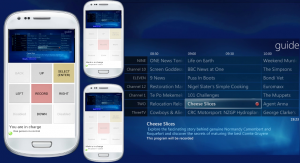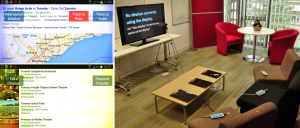Shared Use TV
Motivation

Our shared-use remote control system, where users could manage a virtualised token of control, allowing for new behaviours for managing and sharing use of a traditional single-user TV.
This PhD project is part funded by Bang & Olufsen with the aim of examining how we can design TVs that reflect the social multi-screening environment they often inhabit, providing new capabilities to share and interact by utilizing a common shared focal point and the largest display in the room, the TV.
Work so far
We have published two papers in ACM TVX 2014, one of which received the Best Paper award:
- M. McGill, J. Williamson, and S. A. Brewster, “How to Lose Friends & Alienate People: Sharing Control of a Single-User TV System,”Proceedings of acm tvx 2014, pp. 147-154, 2014.

- M. McGill, J. Williamson, and S. A. Brewster, “Mirror, Mirror, On The Wall: Collaborative Screen-Mirroring for Small Groups,”Proceedings of acm tvx 2014, pp. 147-154, 2014.

Our shared use screen mirroring system. Here, users could share use of the display using some simple on-screen buttons on their mobile devices, allowing for shared-use screen mirroring.
Thus far, our work has examined sharing control of a typically single-user TV through virtualised social mechanisms, before moving on to applying these mechanisms to awareness of other devices in the room, allowing for anyone to take/pass/relinquish use of the TV display.
Our ongoing work is currently continuing this theme of examining how we can share traditional single-view TVs and enhance the awareness of other activities in the room or household, whilst also examining the potential for new display technologies that might allow for shared-yet-independent usage, for example utilizing multi-view displays.

Our multi-view TV prototype. Here, two users can have completely independent, private views of the same physical display. This capability is a double-edged sword: whilst you can use the TV privately, your awareness of other activities is diminished, and thus a capability for providing awareness must be designed for.